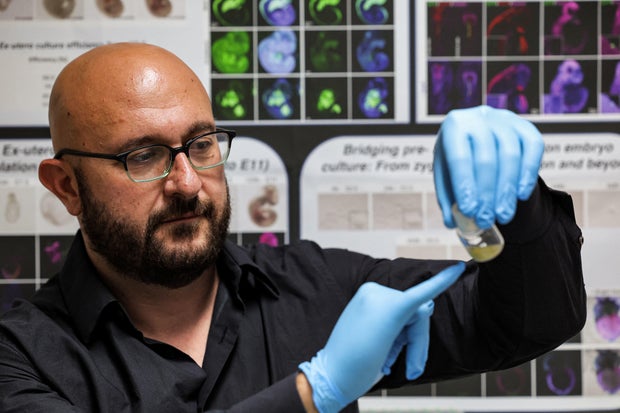[ad_1]
Bangkok — Scientists have developed human embryo-like buildings with out utilizing sperm, an egg or fertilization, providing hope for analysis on miscarriage and beginning defects but in addition elevating contemporary moral considerations.
Earlier this yr, a number of labs around the globe launched pre-print research that had not been peer-reviewed, describing their growth of early human embryo-like buildings. Now one group’s analysis has been revealed within the peer-reviewed journal Nature, describing how they coaxed human embryonic stem cells to self-organize right into a mannequin resembling an early embryo.
The analysis was welcomed by some scientists as an “spectacular” advance that might assist unlock secrets and techniques concerning the precarious early phases of pregnancies, when failure is commonest.
AHMAD GHARABLI/AFP/Getty
The work will nonetheless renew debate on the necessity for clearer moral guidelines on growth of lab-grown human embryo fashions.
The researchers, led by Palestinian scientist Jacob Hanna on the Weizmann Institute in Israel, harnessed the energy of embryonic stem cells, which might turn into any sort of cell. They produced embryo fashions as much as 14 days outdated, which is the authorized restrict for human embryo lab analysis in lots of nations, and the purpose at which organs just like the mind start to develop.
The researchers say their work differs from these of different groups as a result of it makes use of chemically slightly than genetically modified embryonic stem cells and produces fashions extra like actual human embryos, full with yolk sac and amniotic cavity.
These similarities may make the fashions extra helpful for analysis into situations like miscarriage, beginning defects and infertility, stated James Briscoe of Britain’s Francis Crick Institute.
The mannequin “appears to supply all the various kinds of cells that type tissues at this early stage of growth,” stated Briscoe, principal group chief and affiliate analysis director on the biomedical analysis charity.
The analysis “is a step in the direction of opening a window on the interval of human growth the place many pregnancies fail and which has been actually troublesome to check up till now.”
Each the researchers and scientists not concerned within the work emphasised that the fashions shouldn’t be thought-about human embryos.
The construction “extremely resembles, however (is) not an identical, to the in utero state of affairs,” the analysis notes.
The success fee on producing the fashions was additionally low, with the stem cells organizing appropriately only a small proportion of the time.
Nonetheless, “in distinction to related research revealed earlier this yr, these embryo-like buildings contained many of the cell varieties present in creating embryos,” stated Darius Widera, an skilled in stem cell biology on the U.Okay.’s College of Studying.
The analysis and different current work reveals “that fashions of human embryos are getting extra refined and nearer to occasions that happen throughout regular growth.”
That highlights “{that a} sturdy regulatory framework is extra wanted than ever earlier than,” he added.
In Britain, Cambridge College has begun creating the nation’s first governance framework for stem cell-based human embryo fashions.
British regulation prohibits the culturing of human embryos in labs past the 14-day mark, however as a result of the buildings derived from stem cells are fashioned artifically, they don’t seem to be explicitly lined by present rules.
Nonetheless, most researchers have adopted voluntary limits on their work at this stage.
The Weizmann Institute analysis didn’t develop its fashions past 14 days and doesn’t contain transferring the fashions right into a human or animal womb.



